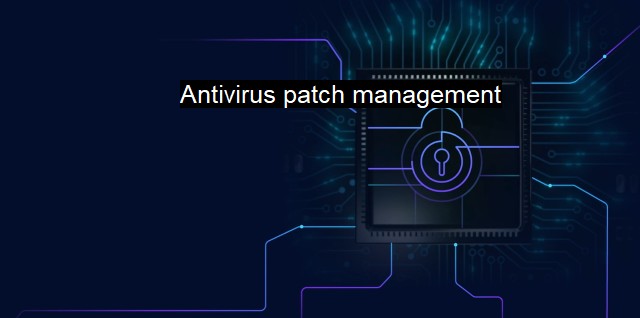What is Antivirus patch management?
The Importance of Antivirus Patch Management for Cybersecurity: Strategies and Best Practices
Antivirus patch management is an important aspect of cybersecurity that helps organizations to maintain the highest possible level of security. It is a vital methodology put in place not only to weather every storm in terms of security vulnerabilities but also to enforce reliable and sustainable solutions for the greater reliability of the antivirus software. It substantially curtails the amount of risk a computer system is exposed to, thus delivering a safer browsing environment for users.The term “antivirus patch management” can be broken down into two parts. ‘Antivirus’ refers to the software designed to detect and remove computer viruses and other malicious software. Next, a ‘patch’ comes into this context as an update made to the software or application. Sometimes, hackers unearth vulnerabilities within the software, which they take advantage of to inject viruses or malware. Therefore, to prevent this kind of infiltration, software designers intermittently send out patches or sustained updates to correct the glitches, bolster the software’s capabilities, or just improve its usability.
Patch management refers to the practice of updating antivirus software with these patches, helping to rectify vulnerabilities in the system. The effective process of patch management involves acquiring, testing, and installing multiple patches on existing system software and applications to ensure their performance, security, and integrity.
Antivirus patch management is critical since the delivery of virus-files is often not easy to discern. A user might download a virus file accidentally by simply visiting a compromised webpage or opening an infected file sent through email. Whatever methods hackers opt for, their attacks are often successful because computer systems and internet security protections are unpatched or outdated. Outdated software creates areas of vulnerability that can be taken advantage of by malware. Patch management safeguards against this security weak spot and insulates computer software consistently.
To achieve an effective antivirus patch management strategy, companies need to continuously monitor their systems for emerging vulnerabilities and have the most recent available patches at hand. It is not unusual for organizations’ IT departments to neglect the importance of patch management. Ironically, for most companies, the reaction arises once the breach has happened, often engaging in the costly process of damage repair post-factum.
No less vital is a systematic and disciplined approach. With a potential for a plethora of patches flooding the system all at once, it's imperative to act judiciously about which patches are required promptly. Organizations often prioritize patches based on the severity or criticality of the bug, deploying patches for critical vulnerabilities immediately.
Another challenge lies in the fact that every patch that’s applied is essentially a software modification. It is possible for a patch to inadvertently introduce new vulnerabilities into a system or to disrupt its operation if some residual bugs in the coding persist.
To overcome these potential issues, patches need to be tested before being widely deployed, an approach also known as pre-deployment testing. Testing ensures that each patch will perform effectively in the organization's particular system environment. It also checks for workability compatibility with all other existing system software.
A mention also needs to be made on how the digital transformation surge we're witnessing, especially since the onset of COVID-19, puts more pressure on IT to develop a more sustainable antivirus patch management program. The lockdown has rendered both organizations and individuals more vulnerable than ever to cyber-attacks, making it vital to reconsider how effectively they manage their antivirus patches.
Antivirus patch management is a constant and necessary process crucial for maintaining foundational defenses against cyber threats. Wearing an idea of the hacker's mindset - anticipating their next course of action and always being a step ahead, stands as critical. With efficient management and regular updating of antivirus software patches, an organization can safely build an impenetrable e-wall, thereby preserving their cybersecurity posture intact. It is indeed, not merely about responding to the existing dangers but also anticipating future security threats and warding them off proactively.

Antivirus patch management FAQs
What is antivirus patch management and why is it important in cybersecurity?
Antivirus patch management refers to the practice of regularly updating antivirus software with the latest patches or updates released by the antivirus vendor. This practice is important in cybersecurity as it helps to address vulnerabilities or weaknesses in the antivirus software that can be exploited by cybercriminals.What are the benefits of implementing antivirus patch management?
Some benefits of implementing antivirus patch management include: ensuring that antivirus software is up-to-date with the latest security patches, reducing the risk of malware infection, improving system performance, and meeting compliance requirements.What are the common challenges associated with antivirus patch management?
Some common challenges associated with antivirus patch management include: managing a large number of endpoints, ensuring that updates are installed correctly, managing conflicting updates, and ensuring that updates do not cause system downtime.What are some best practices for antivirus patch management?
Some best practices for antivirus patch management include: automating the patch management process, testing patches before deployment, prioritizing critical patches, scheduling updates during non-business hours, and having a backup plan in case of any issues that arise during the patching process.| | A | | | B | | | C | | | D | | | E | | | F | | | G | | | H | | | I | | | J | | | K | | | L | | | M | |
| | N | | | O | | | P | | | Q | | | R | | | S | | | T | | | U | | | V | | | W | | | X | | | Y | | | Z | |
| | 1 | | | 2 | | | 3 | | | 4 | | | 7 | | | 8 | | |||||||